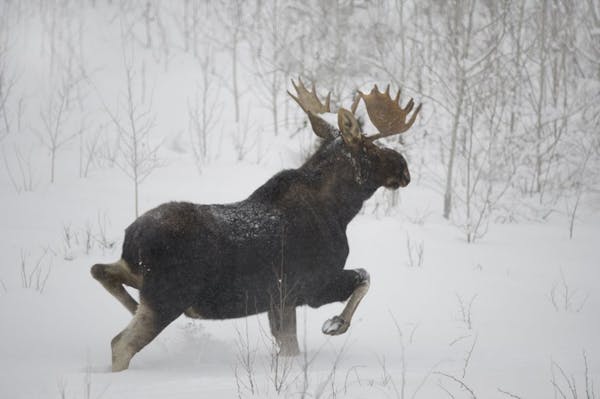Starting this month, some of Minnesota's few remaining moose will become the most intensely studied of all ungulates, when the state launches a major research project designed to figure out why they are rapidly dying out.
Wildlife researchers plan to put sophisticated GPS collars on 150 of the animals, including 50 newborn calves, which will mark their location six times a day and send out an alert when they stop moving -- a sign of distress. Teams of veterinarians and biologists around the state are poised to track down the dead or dying animals, conduct autopsies on the spot, or haul the 1,000-pound carcasses out of the woods and into a lab before they decompose or are eaten by scavengers.
"We want to get in there within 24 hours and see why they died," said Glenn DelGiudice, project leader for the Minnesota Department of Natural Resources (DNR). "This is cutting edge technology."
The $1.2 million project has been in the works for two years, and is expected to continue for six or seven years -- long enough for most of the adult moose to die.
When it's done, said Erika Butler, a DNR veterinarian, the results should provide answers to a question that has puzzled wildlife experts for years.
Moose used to roam most of the northern third of the state. But now they are completely gone from the northwest corner and declining fast in the Arrowhead region. Since 2006 their numbers have declined by half, to 4,200. Earlier this month state wildlife officials put moose on the list of species that are of special concern, a first step toward endangered status.
Earlier studies have linked their deaths to warmer temperatures from climate change. Moose are extraordinarily sensitive to hot weather, and researchers say that when summers are hot they may not eat enough to get them through the winter. Others have found a link between higher death rates and warmer temperatures in the winter as well.
Moose are also susceptible to parasites brought to the north woods by a spreading deer population. And, Butler said, wolves kill a high number of adult moose in Minnesota. Usually, it had been only calves or elderly moose that are preyed upon -- an indication that the adult moose might be weakened or sick, she said.
The research project will follow earlier studies using radio collars conducted by researchers from the University of Minnesota Duluth.
Helicopters will help
In January, when the moose are easy to see against the snow, researchers in helicopters will spot them and sedate them with a dart from the air. Researchers on snowmobiles will find each sleeping moose and hang the large white tracking collar around its neck. Another device attached to the collar will record air temperature.
And a third device will be pushed down the throats and into the stomachs of 27 moose, where it will record the heartbeat and internal body temperatures. When the heart stops, the device will send out an alert signal.
"We will learn an awful lot about what's going on here," said Lou Cornicelli, the DNR's director of wildlife research.
But even so, researchers acknowledged Friday, all the answers they get may not be enough to prevent the eventual disappearance of the moose from Minnesota altogether.
Josephine Marcotty • 612-673-7394

Trail section at one of Minnesota's most iconic spots closing for rehab

Will 'shotgun only' zone for deer in southern Minnesota be abolished?

Four Minnesotans catch salmonella in outbreak linked to basil sold at Trader Joe's

